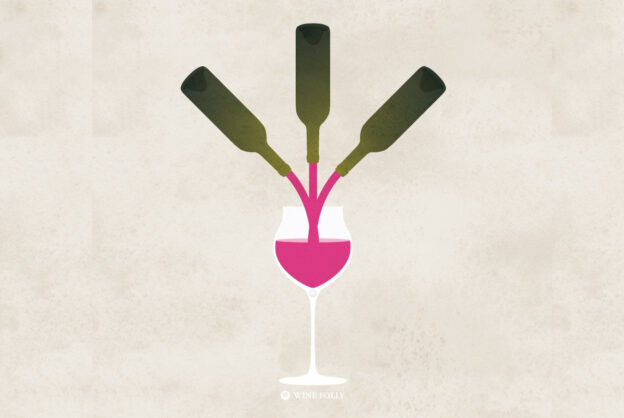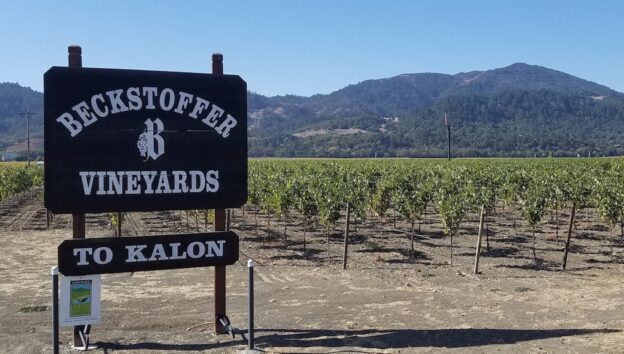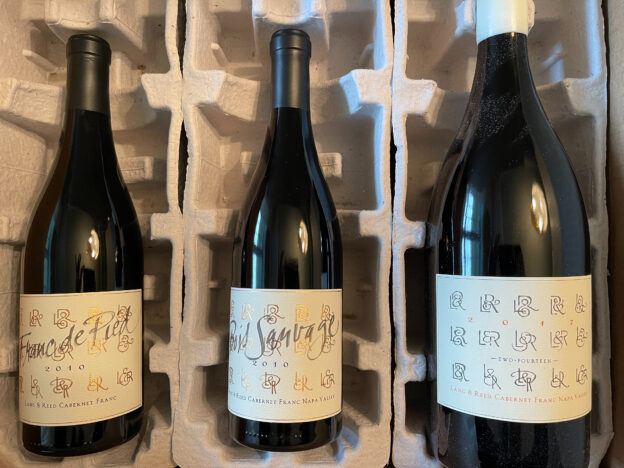The first time someone asked me at one of my wine tasting events why blends were lower quality than single varietal wines, I was taken by surprise. It never occurred to me at the time that this perception even existed. After all, some of my favorite wines, and some of the most prestigious wines in the world, are blends.
After giving it some more thought, I realized this may be more a “New World” perception. After all, some of the most highly reputed wines from the U.S. are labeled as single varietals – Cabernet Sauvignon from Napa Valley, Pinot Noir from Willamette Valley, etc.. Meanwhile, blends are relegated to a small section of the wine shop labeled with the generic term “Blends” and some may not even have grape varieties listed on the label. Many of those wines are also inexpensive mass market labels – Apothic Red, 19 Crimes, etc.
Classic Blends
On the other hand, in classic wine countries in the Old World, they embrace blends.
- Bordeaux, France: Reds are blends of Cabernet Sauvignon, Merlot, Cabernet Franc, Petit Verdot and/or Malbec; whites are blends of Semillon, Sauvignon Blanc and/or Muscadelle.
- Southern Rhone, France: Reds are blends of Grenache, Syrah, Mourvedre and/or more than a dozen other grape varieties; whites are blends of Grenache Blanc, Clairette, Marsanne, Rousanne, and/or many others.
- Champagne, France: Often blends of Pinot Noir and Chardonnay with some Pinot Meunier; and/or blends of vintages.
- Rioja, Spain: Blends of Tempranillo with Graciano, Mazuelo and other varietals.
- Priorat, Spain: Blends of Grenache and Carignan with other varietals.
- Toscana & Bogheri, Italy: “Super Tuscans” are blends of Sangiovese, Cabernet, Merlot, other varietals
There are many more high quality wine blends on the market than you may realize!
What many don’t know is that many wines in the U.S. that are labeled as single varietals are actually blends. We have very few wine laws in the U.S., but one of the major ones says that only 75% of a grape variety is required to label a wine as a single varietal. So your bottle of Napa Valley Cabernet Sauvignon may very well be a Bordeaux style blend with Cabernet Franc, Merlot and/or Petit Verdot included. Your California Pinot Noir may have a little Syrah or Merlot added for deeper color. Your Zinfandel may be a field blend where old Zinfandel vines were planted with a mix of other varieties and they’re all picked and vinified at the same time.
An exception to the 75% rule is Willamette Valley, Oregon, which set a stricter law for Pinot Noir that 90% of grapes must be Pinot Noir to be labeled as such.
Why are wines blended?
When we look at the myriad of reasons why a winemaker would blend a wine, the result can be a wine of higher quality and complexity than single varietals, but can also be an inexpensive mass market wine.
- Balance: Grapes may be blended to create a more balanced, higher quality wine. For example, grapes from warmer areas that have higher sugar and flavor levels may be blended with grapes from cooler areas that bring balancing acidity.
- Complexity: Blending can bring together different characteristics that add complexity of flavors and aromas to make a more interesting and higher quality wine.
- Consistency: Winemakers may try to minimize bottle or vintage variation by blending wines to achieve a specific profile year over year. This is usually done by producers of inexpensive high-volume wines, but is also done with most Sherries and Champagnes.
- Style: Winemakers blend to achieve a desired style. For example, many big label Champagnes (e.g., Veuve Clicquot Yellow Label, Moet & Chandon Imperial, etc.) are designed in a “house style” to achieve a specific flavor profile each year. Some rosés are a blend of red and white grapes to give the winemaker greater control over the final color and flavor profile.
- Price: To be profitable and reduce costs, some winemakers may blend in a portion of less expensive grapes. In places like the U.S., if it’s less than 25% of the blend, these grapes don’t even need to be identified on the label. For example, cheaper Semillon may be added to reduce the price of Chardonnay wines.
- Volume: Producers of high volumes wines, or holders of very small vineyards, may need to purchase wine or grapes from others and blend them together to increase the volume of their production.
- Minimize faults: It is possible that wines will be blended to hide faults. For example, if one barrel became slightly oxidized, it may be blended with larger volumes of good wine until that oxidized character is diluted.
What types of blends are there?
When most people think about blends, they assume it only means blending different grape varieties together. In fact, there are several other ways to create a blend:
- Grapes from different locations (vineyards, regions, countries)
- Grapes, juice or wine purchased from different growers or businesses
- Wines from different vintages (very common with Champagne, Sherry, etc.)
- Wines that have been treated differently in the winery (e.g. wines aged in oak blended with wines made in stainless steel or concrete)
- Wines that have been treated the same in the winery, but are stored in different vessels (e.g. wines stored in small barrels must be blended together before bottling to make up required volume)
Recommendations:
So the next time you’re concerned that your blend is lower quality, think again. Shy away from the inexpensive mass market brands and veer toward the classics and more reputable producers:
- Chateau Ducasse Bordeaux Blanc ($18)
- Daou Pessimist ($22)
- Bodegas LAN Gran Reserva Rioja ($25)
- Alvaro Palacios Camins del Priorat ($26)
- Roederer Estate Anderson Valley Sparkling Wine ($26)
- Chateau de Beaucastel Cotes du Rhone Coudoulet de Beaucastel ($28)


